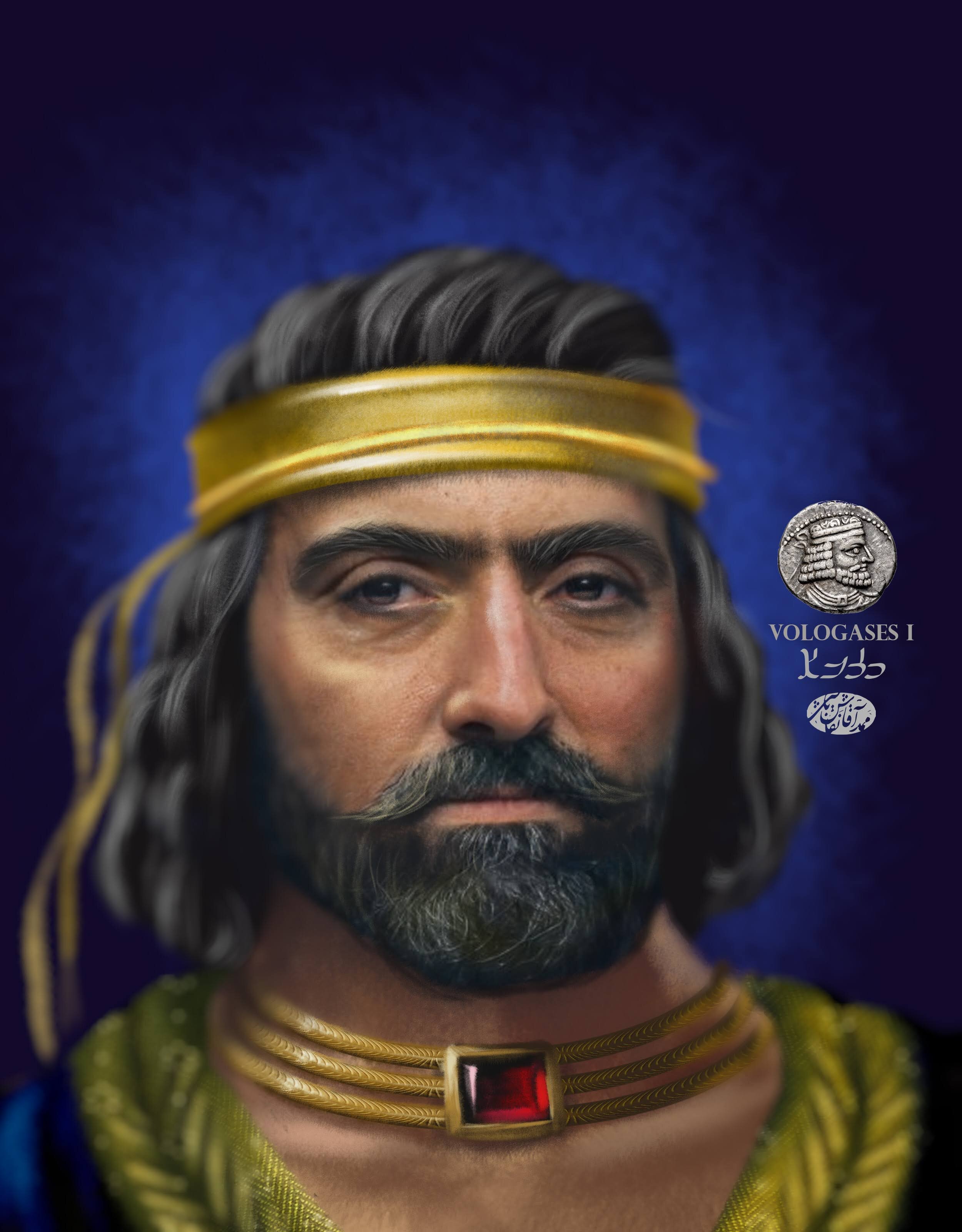Vologases I
51 – 78 AD
Walagash | Walākhsh | Wardākhsh | بَلاش یکم | وَلَگش | 𐭅𐭋𐭂𐭔
A likeness of Vologases imagined based on his coin and on his brother, Tiridates’s look. Download
Ver.1.0 - Last updated: Oct 7th 2021, by Mo. Rasoulipour
Brief Biography
“Vologases I (Walagash) was the son and successor of Vonones II, reigning from 51 to 78.
Early after his accession to the throne, Vologases invaded Armenia and made his younger brother Tiridates, king of Armenia. This happened in the last years of the old Roman emperor Claudius who did not respond to this provocation. However, in 54 the newly ascended Roman emperor Nero sent forces to restore Roman authority in the country. Vologases had to deal with a series of internal revolts and thus failed to keep Tiridates on the Armenian throne. Yet after the revolts had been dealt with, Vologases turned his attention to Armenia and started a war in 58 that lasted until 63. The Romans initially had the upper hand but in 62, suffered a heavy defeat by the Parthians in the Battle of Rhandeia. The war continued for another year until a peace agreement was made in 63. As a result, Tiridates remained king of Armenia but as a vassal of the Roman empire.
Vologases I stood in good relations with the next Roman emperor Vespasian; yet received no support when a nomadic tribe raided and plundered Armenia and Atropatene.
Vologases I later died in 78 and was succeeded by his son Pacorus II.”…
- Excerpt from Wikipedia
Insignia
It is likely that the symbol seen on some of Vologases I’s coins (reverse - behind seated king) represents a family symbol that we see on certain Kings’ coins right up to the last Parthian King, Artabanus IV.
Likely coin of Vologases I - Sellwood 71.4 - Mint: Ecbatana, undated Via Parthian.com: Photo/ by permission Dr. Busso Peus Nachf
Our team’s study and compilation of the personal and family insignia of this era of Iranian history is at its beginning stages. If you are interested in helping this effort please visit the Insignia Project Page.
Name
“The Parthian form of the name, the oldest, is Walagaš. In Middle Persian it is Wardāxš, in Pahlavi Walāxš. The forms Walāš, Balāš, and even Golāš, attested especially in New Persian and in Arabic, are later. Armenian has Vałarš, which seems to be a borrowing from Middle Persian. The Syriac forms Walgāš, Walgēš, and Wologēš are borrowings from Parthian.” - Via Encyclopedia Iranica
References
Coins of Vologases I were one of the primary sources of this recreation. Although the faces of the Kings of this period in the Parthian dynasty on the coins are not as detailed and realistic as the beginning of the Empire, there is much consistency in the features depicted in Vologases I’s coins. Of those are the beard length, the mustache shape, the nose shape, and the unique choker. The necklace, unlike the typical choker of this era of kings, does not appear to coil around. Instead, it seems to have three lines that meet in the middle to what is likely a precious stone centerpiece. That centerpiece is imagined to be Ruby in this recreation but could easily be some other precious stone. The other unique part of the depictions on the coins of this Arsacid king is the headgear. It seems, unlike the kings previous and after him, to show two diadems instead of one. This point was mistakenly imagined as one diadem and a line through, which would be corrected in the next rendition.
The other source used for this recreation is the documented notion that Vologases was the brother of Tiridates I of Armenia, of whom we have a detailed and realistic Roman sculpture. The face of Tiridates is used to create the base of Vologases I’s look.
Likely Accuracy of the Creative Recreation
Weak - Fair Guess:
Due to the lack of realism in coins of this era of the Parthian Empire, we are unable to determine exact looks from the coins. Although the fact that coins of Vologases, especially Sellwood Type 68 coins of him are unusually consistent and clear and that we a good estimation of his brother, Tiridates, face for the reasons explained above, this could be a better guess on. the looks than most other kings of his era.
See the latest work in progress:
Permissions
This is as close as a creative project can get to being open source. You are welcome to download, use, and modify the images.
You are however not permitted to sell the products or place barriers of access for public view and use.
See any issues with this page? Want to say hi to the creator of this page? Reach them via the link below:
Are you a content creator?
If you are a content creator and would like access to the working files please sign up here. We’d love to connect with you and help promote your work.










